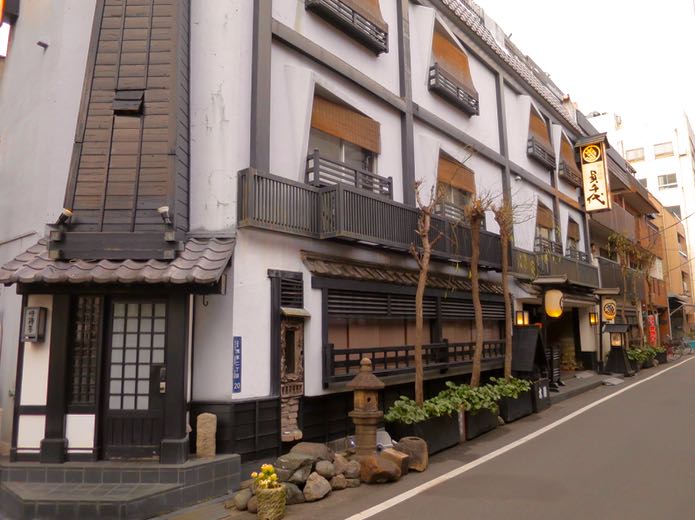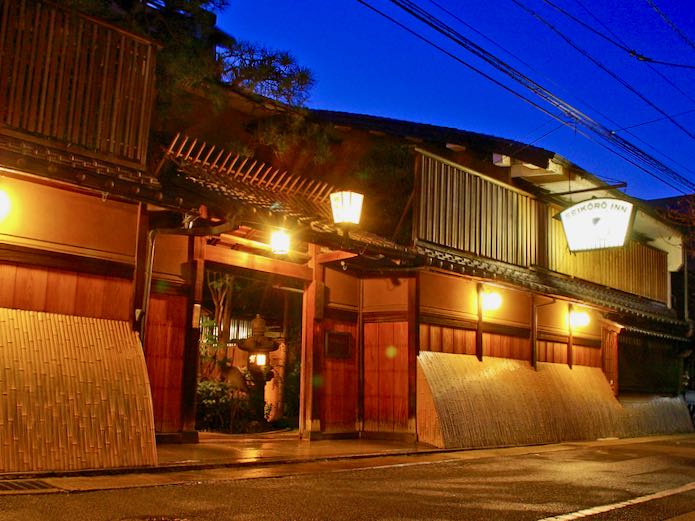SD › Best Ryokans in Japan
Updated: October 16, 2020
By Santorini Dave
See Also
- Where to Stay in Tokyo
- Best Hotels in Tokyo
- Best Hotels for Families in Tokyo
- Best Budget Hotels in Tokyo
- Best Hotels with Pools in Tokyo
- Tokyo Hotel Map

Sadachiyo Ryokan in Tokyo. A great traditional place to stay and one of the few ryokans in Tokyo.
Japanese Ryokan – An Introduction
Staying in a Japanese inn—called a ryokan in Japanese—is a great way to experience traditional Japan. The oldest ryokan date back centuries, when they were built to serve feudal lords and their samurai retainers traveling between Edo (present-day Tokyo) and the provinces. These historic relics stand like sentinels of the past, made mostly of wood and with long gleaming corridors leading to tatami rooms with intricately carved transoms, sliding doors, shoji screens and a low table with cushions. The futon is laid out only for sleeping. Of course, today’s ryokan vary greatly in size, price and atmosphere, from sprawling affairs busy with tour groups to exclusive enclaves with only a dozen or so rooms offering the best service money can buy. Although ryokan are found throughout Japan, they’re concentrated mostly in historic towns like Kyoto, in rural areas, and in Japan’s countless towns and villages with hot-spring spas (onsen).
If you’re staying in a first-class ryokan, you can expect impeccably decorated rooms ranging from antique historic to Zen modern, meals fit for an emperor and personalized service. Etiquette dictates that you take your shoes off at the entryway and slip into the proffered slippers before being led by a kimono-clad hostess to your tatami room, where you shed the slippers before entering. Your room might have a view of a private garden and your tub might be made of cypress. Your room attendant will bring welcome tea and a sweet, but it’s the hot bath that’s the clincher, either in your room or the communal bath. If you’re staying in an onsen, you might even have the luxury of a rotenburo (outdoor thermal bath). To feel fully at home, you’ll then don the yukata (cotton robe) provided by your ryokan. Your kaiseki dinner, served either in the privacy of your own room or the inn’s dining hall, will be a feast of many local dishes and seasonal delicacies, artfully arranged. You’ll sleep on a futon laid out on the tatami floor, or, in a contemporary ryokan, on a raised platform. The next morning, after breakfast (many ryokan offer either Western or Japanese options), your hostess will see you off at the front gate, bowing as you depart feeling rejuvenated and pampered. Although rates for a ryokan, which are always per person, can seem high, they include two meals and often service charge and tax.
Although a top-class ryokan is worth the splurge at least once during your travels, there are also moderately priced inns that don’t provide as much individualized service but offer the opportunity to sleep on a futon in a tatami room and dine on local specialties. Many of these cater mostly to families and groups and serve set meals or buffets in a communal dining hall. Even cheaper are inns that may or not serve meals and have shared bathroom facilities down the hall. A minshuku is Japanese-style lodging in a private home, the Japanese version of a small bed-and-breakfast. Regardless of your budget, staying in a Japanese inn could well be the highlight of your trip and an experience you won’t soon forget.
The Best Ryokan in Tokyo
1. Hoshinoya Tokyo
Tokyo has few ryokan – land is so expensive, most were long ago gobbled up by developers. But this luxury entry has bucked the trend, opening in 2016 in the heart of the capital near Tokyo Station. With only 84 rooms, Hoshinoya creates a relaxing and intimate oasis, with tatami rather than wood floors running throughout the inn, even in the elevators. There’s a lounge for every six rooms, where attendants are on hand to serve snacks and provide personalized service. Spacious rooms are decorated in a minimalist style that blends natural materials like wood and bamboo with high-tech features. Bonuses include a top-floor onsen open to the sky and a restaurant specializing in French cuisine made with Japanese ingredients.
2. Sadachiyo
This moderately priced inn is one of Tokyo’s oldest, established about 70 years ago and located in the delightful Asakusa neighborhood. It imparts an atmosphere reminiscent of centuries past, from the rickshaw parked outside its front door to staff dressed in period clothing. Its 20 tatami guest rooms are decorated with antiques, woodblock prints, shoji screens and other traditional flourishes, with some large enough for a family of six. Extensive Japanese meals are optional, but you’ll get in the mood by dining in, followed by a soak in the inn’s public baths.
3. Homeikan
Located in a quiet residential neighborhood, Homeikan is the umbrella name for three separate Japanese inns, all acquired by the present owner’s family over more than a century and all with striking architectural details. The Honkan (main building) is the oldest and has the distinction of being a Listed Tangible Cultural Property, while the Daimachi, built as the family home after World War II, is probably the most popular due to its Japanese garden and communal mineral bath. Note, however, that none of Homeikan’s 89 rooms have a private bathroom or modern conveniences like Wi-Fi, and meals are not served. It is, however, a jewel of an inn and provides a unique look at how Tokyo’s upper class lived in the days of yore.
4. Ryokan Sawanoya
Ryokan Sawanoya is a fine example of an inexpensive Japanese inn, managed since 1949 by three successive generations of the same family and offering a heartfelt welcome to international travelers for decades. Advertising itself as LGBT friendly, it offers 12 tatami rooms (only two with private bathroom), two Japanese-style baths which can be locked for privacy, and a lounge with free tea and coffee and breakfast available on request. Surrounding Sawanoya is Ueno, known for its old downtown atmosphere, with Nezu Shrine and Ueno Park with its many museums within walking distance.
The Best Ryokan in Kyoto

Seikoro Ryokan – The best ryokan in Kyoto, Japan.
5. Seikoro Ryokan
Established in 1831, this is one of Kyoto’s most atmospheric inns. Located east of the Kamo River, it’s filled with antiques and character, especially in the 120-year-old main building where the best rooms open onto the garden (rooms in the annex, built just before the 1964 Olympics, look out over rooftops). During the offseason, Seikoro gives the option of room rates without meals for about the same price you’d pay at a medium-priced hotel, but frankly, it would be a shame to miss the experience of a kaiseki dinner served in the privacy of your room. The large public bath is made of 400-year-old cypress, making it the pride and joy of this ryokan.
6. Hiiragiya Ryokan
One of Kyoto’s most famous inns, Hiiragiya was established in 1818 and has played host to writers, politicians and even members of the imperial family. Located in the heart of the city and owned by the same family of innkeepers for six generations, it exudes all the quintessential graceful elements of a traditional inn, with 28 tatami rooms spread in the main historic building and in a modern wing. Each room is uniquely decorated, whether it’s a folding screen painted on gold leaf or an ink drawing on handmade paper, but all have the traditional hand-carved transoms and reed ceilings. Some have views of the garden. Kyoto-style kaiseki cuisine is served in your room in true ryokan fashion.
7. Hotel Kanra Kyoto
Hotel Kanra Kyoto is a hip hybrid between a hotel and a ryokan, with a sleek design that nevertheless borrows architectural details from the many machiya (merchant houses) that once graced many Kyoto neighborhoods. Its 68 spotless rooms, hidden behind lattice doors and spread between the main building and an annex, are stylishly modern, with wood or granite floors, shoji screens, raised platform beds, tatami areas for relaxing and cypress soaking tubs (and separate showers). The English-speaking staff is especially helpful and always seems to be waiting just for you. Because meals aren’t included in its rates, this is a good choice for travelers who wish to experience the atmosphere of a contemporary ryokan but wish to dine elsewhere.
8. Nishiyama Ryokan
Located just a few minutes’ walk from downtown, this moderately-priced inn was founded about 50 years ago by the present owner’s grandfather. Because of its low prices and convenient location, it’s always filled with travelers from around the world, youth groups and budget-minded Japanese. Although it occupies a nondescript five-story building, the inn strives for authenticity with an interior that includes traditional Japanese touches in the lobby and courtyard garden, a public bath complete with waterfall and free public events like a demonstration of the tea ceremony, an origami session and koto concerts. Its 30 rooms are mostly Japanese style, and kaiseki meals are available if booked in advance.
The Best Ryokan in the Rest of Japan
9. Arai Ryokan – Izu
Located in the center of Shuzenji, a popular onsen weekend getaway from Tokyo on the Izu Peninsula, this inn opened in 1872 and has welcomed many Japanese celebrities since then, including artists, writers and kabuki actors. Its 15 structures, all registered as national cultural assets and centered on a river-fed pond, include the majestic main building, a wooden covered bridge leading to rooms and a century-old onsen bathhouse. Its 30 rooms are spread through several wooden buildings dating mostly between 1899 and 1935, the best of which face the pond and Katsura River (not all rooms have private bathrooms). Traditional kaiseki meals change monthly and are served in your room. There are several options for onsen bathing, including a rotenburo encircled by boulders.
10. Gora Kadan – Hakone
This top-rated ryokan, nestled among woods and gardens in Hakone, exemplifies the Japanese knack for elevating simplicity into eye-catching, understated elegance. Guests check in here to check out, where the emphasis is clearly on the restorative powers of indoor and outdoor spring baths and various spa treatments, with an indoor heated swimming pool and a small gym for those inspired to work out. Rooms are minimalist modern, all with direct access to balconies or gardens and the more expensive with rotenburo. Its kaiseki meals are celebrations of the season. For lunch, there’s also a restaurant, an Elizabethan-style half-timbered building that once served as a former summer residence of the imperial family.
11. Ryokan Kurashiki – Kurashiki
Kurashiki’s historic old town centers on a willow-lined canal and centuries-old black-and-white granaries now converted into shops, restaurants, museums and this exclusive ryokan, which occupies three renovated warehouses and an old mansion. Its eight rooms are actually suites, with separate bedrooms fitted with two Western-style double beds plus traditional tatami rooms, some with views of the picturesque canal. Kaiseki dinners can be served in your room or in a private room overlooking the canal, while breakfasts are served in the inn’s delightful terrace tea lounge overlooking the inn’s small garden.
12. Minamikan – Matsue
Hugging the shores of Lake Shinji, this historic inn has a 130-year-old history, evident in its 1888 main building and its highly-ranked garden with 300-year-old pine trees. A variety of rooms are available, including Japanese-style tatami rooms and combination rooms with both beds and tatami areas, all with views of the lake and/or garden. Some of the combination rooms even have onsen baths overlooking the lake, but there’s also a public onsen with views of the water. Meals feature seasonal catches from Lake Shinji and the Sea of Japan, along with regional ingredients. The inn’s restaurant is very popular with locals for its one-pot rice meal served with sea bream and other ingredients.
13. Kurayado Iroha – Miyajima
This contemporary lodging boasts a great location on the main pedestrian shopping street of Miyajima, a jewel of an island famous for its Itsukushima Shrine (a World Heritage Site) and views of the Seto Inland Sea. Laid back but with a meticulously efficient staff, it offers several types of rooms, from Japanese-style tatami rooms (the cheapest, but they face only an inner courtyard) to combination rooms with beds and tatami areas, the best of which offer sweeping views of the sea. Guests are asked beforehand about allergies and food preferences for the seemingly endless kaiseki meal served in the dining room, certainly the highlight of a stay here along with the open-air rooftop bath and flawless service.
14. Kannawa-en – Beppu
Beppu is one of Japan’s most famous spa resorts, and though Kannawa-en lies in the tourist thick of things, it’s worlds apart, hidden from sight. In fact, Kannawa-en is like a village unto itself, with ponds, beautifully landscaped gardens and a series of buildings housing Western-style rooms, combination rooms with private rotenburo, and even free-standing suite villas. Because the inn has its own natural hot springs, its curative waters run through all guest rooms and the communal indoor and outdoor baths. Dinners, served in the main building, feature Black Japanese beef, seasonal organic vegetables and fresh seafood. In addition to a spa, the inn also has a thatched-roof teahouse and even its own Noh theater, where plays and music are performed.
15. Tsuru-no-yu Onsen – Tohoku
Located in rural Tohoku, this remote ryokan looks like the set of a samurai movie. In fact, its hot springs have been drawing bathers since the 17th century. Its thatched-roof row house, housing 5 tatami guest rooms, is more than a century old, with an additional 30 rooms in rambling hillside wings added over the years. The main draws are its indoor/outdoor baths, each with different mineral compositions thought to treat different ailments. Meals, served either in your room or a dining hall depending on where you’re staying, feature local mountain vegetables and grilled fish. Because this is a rustic place, with some rooms having toilets but none with private bathrooms, prices are reasonable. But for travelers not willing to rough it, there’s a modern annex down the road called Yama no Yado with private bathrooms at a higher price.
 Santorini Dave was started in 2011 by a guy who loved Greece, travel, and great hotels. We're now a small team of writers and researchers on a mission to deliver the most helpful travel content on the internet. We specialize in
Santorini Dave was started in 2011 by a guy who loved Greece, travel, and great hotels. We're now a small team of writers and researchers on a mission to deliver the most helpful travel content on the internet. We specialize in
We are planning a Japan trip in October and November. How far in advance should we book ryokans and hotels?
The best places (especially ryokan that typically have just a handful of rooms) get booked 4 to 8 months in advance. The sooner the better – and October and November can be busy months for top places to stay.